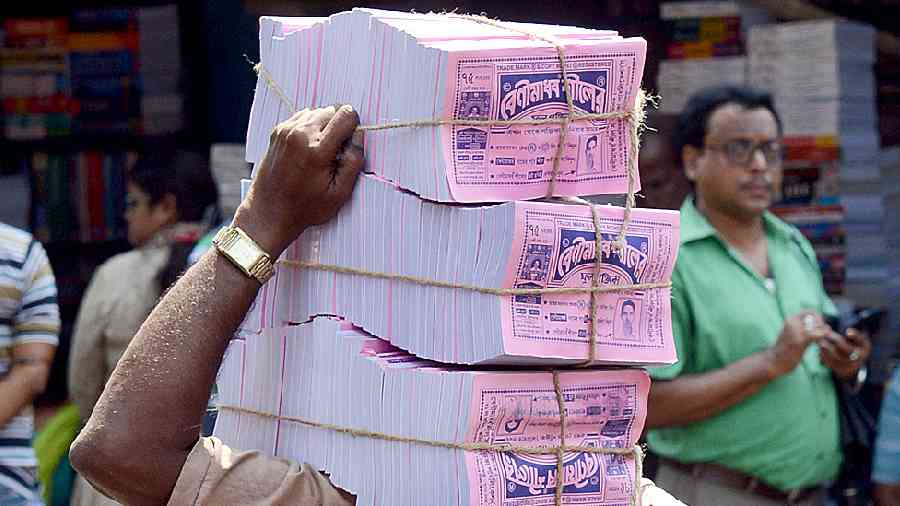The daibagyas started it all. Many centuries ago, these low-ranking Brahmins turned themselves into self-styled messengers-cum-astrologers, travelling from one village to another, carrying manuscripts in which they had scribbled positions of planets based on ancient astrological calculations. It was they who advised people on auspicious dates for weddings and naming ceremonies, and even sowing and harvest. And during Chaitra, the last month of the traditional Hindu calendar, defying the scorching summer sun, it was they who drew up the detailed calendar for the next year.
Over two centuries ago, the handwritten palm leaf almanacs of the daibagyas were replaced. Legend has it that one Ramhari, a daibagya from some village in central Bengal, collaborated with a publisher called Durgaprasad of Jorasanko in Calcutta to bring out the traditional panjika or almanac in printed form. Unwittingly, this Ramhari signed the death warrant of his own ilk. Panjikas, however, remain integral to the life of people across India.
Nilay Kumar Saha, who has been studying the role of panjikas in society for over three decades and has written the book Bengali Almanac: An Uncharted Area of Mass Communication, talks of panjikas as a powerful medium of mass communication for millions.
According to him, contrary to popular misconception, panjikas are not just guidebooks for the religious-minded. The publishers of multiple Bengali almanacs — Bisuddho Siddhanta, Gupta Press, Benimadhab Seal, P.M. Bagchi, Madan Gupta and so on — play a significant role in daily life even while they are locked in a highly competitive battle to capture the lucrative market of printed books.
The information in the earlier almanacs would range from advice on agricultural practices (when to sow seeds or harvest the crop), entrepreneurship (how to apply for trade licences or buy essential equipment), healthcare (details of doctors’ clinics, hospitals and medicines, even aphrodisiacs), education (when and how to apply for admission to schools, colleges or universities), transport (timetables of trains, buses and steamers), judiciary (how to apply for affidavits) and even administration (when and how to meet local politicians). Says Saha, “There was a time when panjika publishers inserted free advertisements to help new enterprises.”
The biggest drawback of the early panjikas was their method of calculating days, months and years, all based on an ancient school of astrology. This traditional system continues to focus on the navagraha or nine planets, including the non-existent Rahu and Ketu — the so-called “evil” planets believed to devour the sun and the moon during solar and lunar eclipses.
After Independence, India decided to use the Gregorian calendar for official work but the public holidays based on local religious festivals hit a strange hurdle. When the country’s first prime minister, Jawaharlal Nehru, realised there were 30 different astrological almanacs and too many date-management systems, he set up the Calendar Reform Committee in 1952 and appointed astrophysicist Meghnad Saha as its head.
The idea was to create a unified calendar system and a scientific almanac based on the most accurate and modern astronomical data, as opposed to ancient unscientific calculations based on myths and legends. This work was supposed to unify a nation eddied in diversity.
Among the members of the committee was Nirmal Chandra Lahiri, who was the publisher of Bisuddho Siddhanta. Says his grandson Sampurna Lahiri, who is also the current publisher of the panjika, “The committee recommended an almanac incorporating data calculated with the most modern astronomical formulae, the National Calendar of India (using Saka era) with tithis, nakshatras, critical yogs, etc. and also festival dates. The committee also asked for the preparation of the Rashtriya Panchang using the solar calendar system for civil purposes and a lunisolar calendar system for religious purposes.”
Later, however, it was decided that the work should be done by a special unit attached to a scientific research department of the Government of India. Much later, in the 1970s, the Positional Astronomy Centre (PAC) was founded in Calcutta to continue this work.
“While the PAC brings out Rashtriya Panchang in 12 Indian languages, we follow the same scientific calculation for our Bisuddha Siddhanta Panjika,” says Lahiri. “Our panjika is accepted by religious organisations such as the Ramakrishna Mission, Kanchi Math, Deoghar Satsang Ashram and many puja committees in India and abroad.”
Barid Baran Ghosh, who is president of the Bangiya Sahitya Parishad, draws attention to the erstwhile role of panjikas in shaping societal sensibilities. Says Ghosh, “Advertisements of cosmetics and even lingerie for women in 19th century panjikas say a lot about their role in women’s emancipation.” Panjikas also became one of those early public platforms where one could read about “forbidden things” such as aphrodisiacs, sexual diseases, once again through advertisements.
The panjika has surely evolved. Today, its editions carry adverts for brides and grooms alongside those of diagnostic clinics while drawing attention to the fact that it is important to check for blood disorders before tying the knot.
Says Ghosh, “The rural Indian continues to put a lot of faith in the panjika. The only quibble I have is that what was once — notwithstanding the commercial reason for its being — a vehicle of social awareness has now ceded much space to the astrologers’ cohort.” Advertisements of this kavach and that vashikaran abound.
But that cannot be the fault of the panjikas, right? They merely pick up the pulse of the times.











